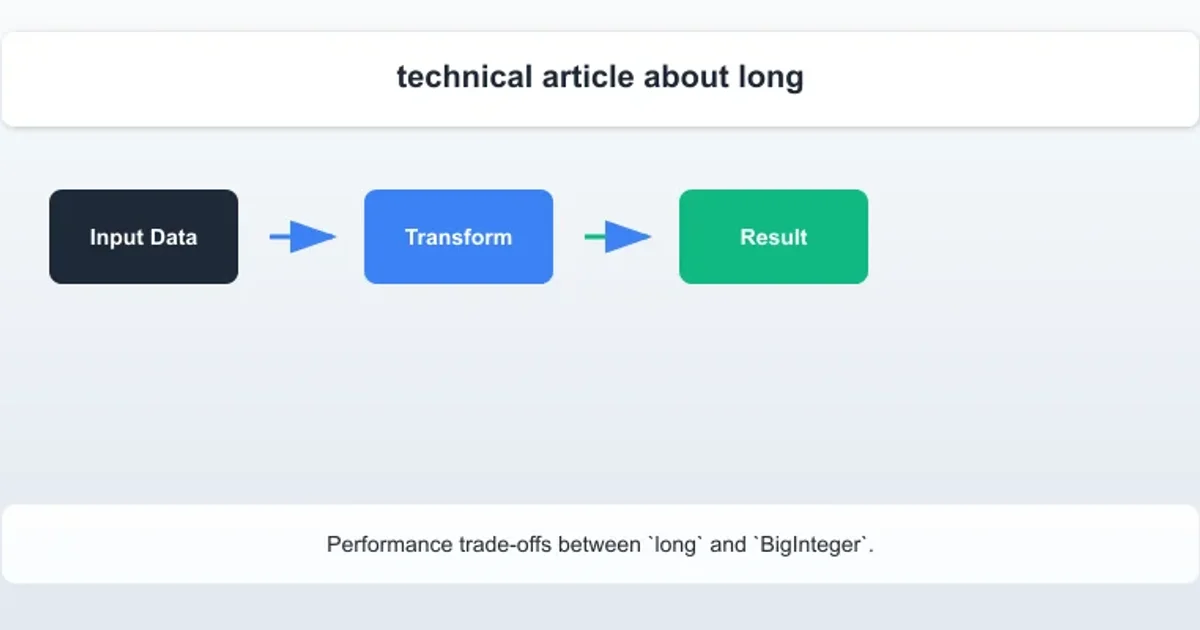A long bigger than Long.MAX_VALUE
Categories:
Handling Numbers Larger Than Java's long Maximum Value

Explore strategies for representing and manipulating integer values that exceed the capacity of Java's long primitive type, focusing on BigInteger.
In Java, the long primitive type can store integer values ranging from Long.MIN_VALUE (-9,223,372,036,854,775,808) to Long.MAX_VALUE (9,223,372,036,854,775,807). While this range is substantial, there are many scenarios in computing, especially in cryptography, scientific calculations, or financial applications, where numbers can easily exceed these limits. When you encounter such a requirement, attempting to store these values in a long will lead to overflow errors, data corruption, or incorrect calculations. This article delves into how Java addresses this challenge, primarily through the java.math.BigInteger class, and provides practical examples for its use.
The Problem: long Overflow
Understanding the limitations of primitive types is crucial. When an arithmetic operation results in a value outside the range of its data type, an overflow occurs. For long, this means any number greater than Long.MAX_VALUE or less than Long.MIN_VALUE cannot be accurately represented. This doesn't typically throw an exception in Java; instead, the value 'wraps around', leading to unexpected and often hard-to-debug results. For instance, adding 1 to Long.MAX_VALUE results in Long.MIN_VALUE.
public class LongOverflow {
public static void main(String[] args) {
long maxLong = Long.MAX_VALUE;
System.out.println("Long.MAX_VALUE: " + maxLong); // 9223372036854775807
long overflowedLong = maxLong + 1;
System.out.println("Long.MAX_VALUE + 1: " + overflowedLong); // -9223372036854775808 (Long.MIN_VALUE)
long largeNumber = 10_000_000_000_000_000_000L; // This compiles, but is already close to MAX_VALUE
// long tooLarge = 10_000_000_000_000_000_000_000L; // Compile-time error: integer number too large
}
}
Demonstrating long overflow behavior in Java.
long arithmetic when dealing with potentially large numbers. Silent overflows can lead to critical errors in applications, especially in financial or security-sensitive contexts.The Solution: java.math.BigInteger
Java provides the java.math.BigInteger class to handle arbitrarily large integers. Unlike primitive types, BigInteger objects store numbers as arrays of digits, allowing them to grow dynamically to accommodate any size, limited only by available memory. This class offers methods for all standard arithmetic operations (addition, subtraction, multiplication, division, modulo), bitwise operations, and conversions to and from other primitive types and string representations.
flowchart TD
A[Start with a large number string] --> B{Create BigInteger instance}
B --> C[Perform arithmetic operations]
C --> D[Convert to other types or print]
D --> E[End]Workflow for handling large numbers using BigInteger.
import java.math.BigInteger;
public class BigIntegerExample {
public static void main(String[] args) {
// Create BigInteger from a string
BigInteger veryLargeNumber = new BigInteger("9223372036854775807"); // Long.MAX_VALUE
BigInteger one = BigInteger.ONE;
// Addition
BigInteger resultAdd = veryLargeNumber.add(one);
System.out.println("Long.MAX_VALUE + 1 (BigInteger): " + resultAdd);
// Expected: 9223372036854775808
// Even larger number
BigInteger trulyMassiveNumber = new BigInteger("123456789012345678901234567890");
BigInteger anotherMassiveNumber = new BigInteger("987654321098765432109876543210");
// Multiplication
BigInteger product = trulyMassiveNumber.multiply(anotherMassiveNumber);
System.out.println("Product: " + product);
// Division
BigInteger quotient = product.divide(trulyMassiveNumber);
System.out.println("Quotient (should be anotherMassiveNumber): " + quotient);
// Comparison
if (trulyMassiveNumber.compareTo(anotherMassiveNumber) < 0) {
System.out.println("trulyMassiveNumber is smaller than anotherMassiveNumber");
}
// Conversion to long (if it fits)
try {
long convertedLong = resultAdd.longValueExact(); // Throws ArithmeticException if it doesn't fit
System.out.println("Converted to long: " + convertedLong);
} catch (ArithmeticException e) {
System.out.println("Cannot convert resultAdd to long: " + e.getMessage());
}
}
}
Basic arithmetic operations and conversions using BigInteger.
BigInteger objects from String representations for numbers that might exceed long's capacity. Using long literals directly can lead to compile-time errors or implicit truncation if the literal itself is too large.Performance Considerations
While BigInteger offers unparalleled flexibility for large numbers, it comes with a performance overhead compared to primitive types. Operations on BigInteger objects are generally slower because they involve object creation, method calls, and dynamic memory allocation, rather than direct CPU instructions on fixed-size data. For most applications, long is sufficient and significantly faster. Use BigInteger only when the number range genuinely necessitates it.

Performance trade-offs between long and BigInteger.
In summary, when your Java application needs to handle integer values that can exceed Long.MAX_VALUE, java.math.BigInteger is the standard and most robust solution. It provides the necessary functionality for arbitrary-precision integer arithmetic, ensuring accuracy for even the most demanding calculations, albeit with a slight performance cost.